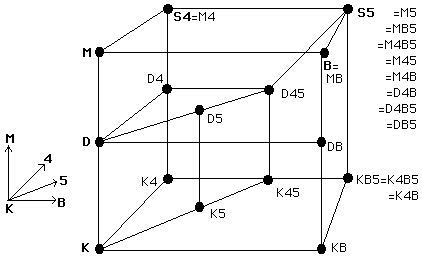When considering the impossible worlds it will be handy to adjust the valuations a bit. Let each valuation be the set of all propositions, except if a proposition p* is false at world w*, take p* out of the valuation for w* and replace it with ~p*. So a valuation may look something like this: {p1,~p2,p3,p4,~p5,…}. You can make a one-one mapping from the previous notion of valuation onto this new one, so it doesn’t screw up any cardinality issues I’m working with. Now consider the impossible worlds. They are free to have as a subset of their valuation {p*,~p*}. If we accept that there are gappy impossible worlds, then the valuation is free to leave p* out altogether (I’m assuming impossible worlds are not closed under entailment, badness would result). I’ll use “(p)” to represent p not having a truth value and “
” to represent p as having both truth values. So a valuation for an impossible world might look like {p1,(p2),
So we have two sets of non-terminating strings of integers, one using only 0 and 1, the other using only 0-3. This was a surprising result for me, since this corresponds to the base 2 real numbers, and the base 4 real numbers. Thus they have the same cardinality. I won’t go through the whole proof, but in short: You can make a one-one mapping from the base 2 natural numbers to the base 4 natural numbers (anyone who’s taken comp-sci will know how to do this). The real numbers are obtained by taking the power set of the natural numbers (do this in a way similar to the one I used to generate the possible worlds above). If you take the power set of one set, and the power set of another, and the original sets had the same cardinality, I’d venture a guess that the resulting sets also have the same cardinality.
Why is this relevant? For one, I started out trying to prove that there were a great many more impossible worlds than possible worlds, thinking that would make trouble for Lewis if he added them. But, I got the opposite result. The result being, the addition of impossible worlds doesn’t add that much more to your ontology (in terms of the mere quantity of postulated entities). If adding them makes your ontology profligate it would be because of the nature of the impossible worlds themselves. Also, it’s handy to know that any cardinality issue that pertains to the possible worlds will carry over to the impossible worlds.
This is all, of course, in terms of logical impossibility. Metaphysical possibility would be much harder to capture, since what is and is not metaphysically impossible is still on the table (as far as I understand).

3 comments:
In connection with Dan's post, I think it is also interesting to point out that Lewis distinguishes 2 "kinds" of ontological parsimony: qualitative and quantitative. Qualitative parsimony for a theory involves keeping down the number of fundamentally different KINDS of entity the theory posits; quantitative parsimony involves keeping down the number of INSTANCES of the kinds posited by the theory. Lewis defends GR from the claim that GR is ontologically profligate by distinguishing between these two kinds of parsimony,and then arguing that GR is only quantitatively, but not qualitatively, unparsimonious. And this, he suggests, is no problem for GR: Since we believe in the actual world, he argues, we need believe in only (many) more things of the same sort as the actual world, and not (many) more things of some new kind.
and so, if someone were to lump possible worlds and impossible worlds into the same ontological category (probably and abstract realist of some sort), the addition of impossible worlds would not make the theory any more profligate in either sense.
The approach for determining the number of possible worlds may not go through. Recall that propositions are sets of worlds on Lewis's account and the notion of an atomic proposition does not make much sense here: anything logically equivalent to an atomic sentence corresponds to the same proposition.
The number of possible worlds directly depends on the number of possible individuals and, as we saw last week, there is something of a problem determining how many of those things there are.
Even more problems arise if we have reason to think that there are too many individuals to form a set. I alluded to such an argument from Daniel Nolan that apparently convinced Lewis. One version of the problem is the possibility of hypergunk: stuff such that for any decomposition of it into parts, there is another decomposition of it into a strictly greater cardinality of parts. I'll post/link about this separately.
That said, your result is quite clever and, as far as I can tell, (conditionally) correct.
Post a Comment